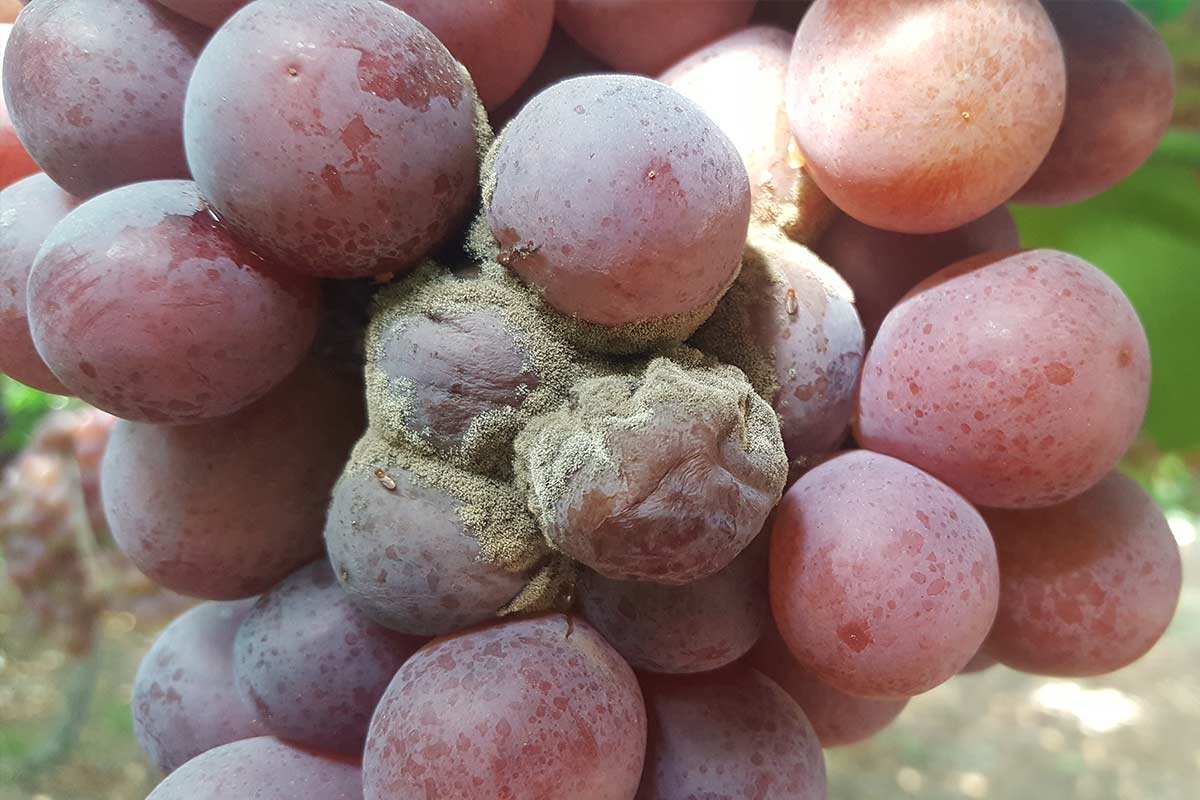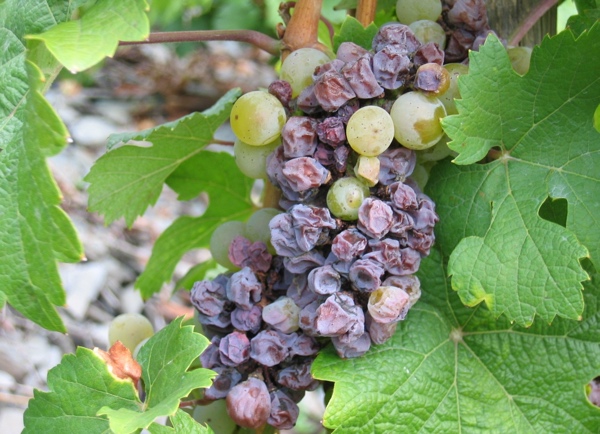
Gray Rot
Botrytis Cinerea
Pathogen:
Fungus
Type:
Risk:
HIGH





DESCRIPTION
Pathogen description
Botrytis cinerea is a necrotrophic fungus that affects a wide variety of plants, including grapevines. During cold seasons, the pathogen survives in the form of sclerotia or latent mycelium in plant residues and affected tissues. Under favorable conditions, typically with mild temperatures and high humidity, the fungus develops conidia that are dispersed by wind or water. These conidia germinate and penetrate the vine tissues through wounds or natural openings, such as stomata. Once inside the tissues, the fungus grows and degrades the plant cells, releasing enzymes and toxins that kill the cells to feed on the remains. As the disease progresses, the fungus can sporulate again, allowing new generations of conidia to infect other parts of the plant or nearby plants.
Disease description
Gray rot caused by Botrytis cinerea is a disease that can affect both the leaves and the shoots and clusters of the vine, especially under humid weather conditions. The pathogen causes a progressive deterioration of plant tissues, which negatively impacts the quality and yield of the crop. The most visible symptom is the appearance of a layer of gray mold on the affected areas, which may be followed by the decomposition of the tissues, which become soft and watery.
- Discoloration and wilting of leaves.
- Appearance of a grayish mold on the shoots and clusters.
- Aqueous decomposition of the affected tissues.
- Premature fall of infected leaves.
- Loss of quality in the grapes, with cracking and mummification of the fruits.
- Significant reduction in crop yield if not controlled in time.

TEMPERATURE AND HUMIDITY
18°C - 25°C
85% - 95%

VOIES DE TRANSMISSION
Conidia carried by wind, water droplets, direct contact with infected tissues, infected plant residues, contaminated pruning tools

Chemical treatments
CONTROL
• AZOXISTROBIN 25% [SC] P/V
• BOSCALIDA 50% [WG] P/P
• CYMOXANIL 4% + FOLPET 33.4% [SC] P/V
• CIPRODINIL 18.75% + TEBUCONAZOLE 12.5% [EC] P/V
• CIPRODINIL 30% [EC] P/V
• CIPRODINIL 37.5% + FLUDIOXONIL 25% [WG] P/P
• DIFENOCONAZOLE 25% [EC] P/V
• EUGENOL 3.3% + GERANIOL 6.6% + THYMOL 6.6% [CS] P/V
• PHENHEXAMIDE 50% [SC] P/V
• PHENHEXAMIDE 50% [WG] P/P
• PHENPIRAZAMINE 50% [WG] P/P
• FLUDIOXONIL 50% [WG] P/P
• FLUOPYRAM 50% [SC] P/V
• FOLPET 50% [SC] P/V
• FOLPET 80% [WG] P/P
• POTASSIUM PHOSPHONATES 50.4% (exp. as phosphorous acid) [SL] P/V
• POTASSIUM HYDROGEN CARBONATE 0.425% [AL] P/V
• POTASSIUM HYDROGEN CARBONATE 85% [SP] P/P
• ISOFETAMID 40% [SC] P/V
• LAMINARIN 4.5% [SL] P/S
• MEPANIPIRIM 50% [WP] P/P
• COPPER OXYCHLORIDE 35% (exp. in Cu) [WG] P/P
• TEBUCONAZOLE 20% [EC] P/V
• TEBUCONAZOLE 20% [EW] P/V
• TEBUCONAZOLE 25% [EC] P/V
• TEBUCONAZOLE 25% [EW] P/V
• TEBUCONAZOLE 25% [WG] P/P
Treatments authorized in organic farming
• EUGENOL 3.3% + GERANIOL 6.6% + THYMOL 6.6% [CS] P/V
• POTASSIUM HYDROGEN CARBONATE 0.425% [AL] P/V
• POTASSIUM HYDROGEN CARBONATE 85% [SP] P/P
• LAMINARIN 4.5% [SL] P/S
• COPPER OXYCHLORIDE 35% (exp. in Cu) [WG] P/P
Biological control
• AUREOBASIDIUM PULLULANS (STRAIN DSM 14940) 50% (2.5
• BACILLUS AMYLOLIQUEFACIENS (strain AH2) (1x10E11 CFU/l) [SC] P/V
• BACILLUS AMYLOLIQUEFACIENS (strain FZB24) 13% [WP] P/P
• BACILLUS AMYLOLIQUEFACIENS (MBI 600 strain) 11% [WP] P/P
• BACILLUS AMYLOLIQUEFACIENS (subsp. plantarum, strain D747) 25% [WG] P/P
• BACILLUS SUBTILIS (strain IAB/BS03) (1 x 10E8 cfu/ml) 10 g/l [SL] P/V
• BACILLUS SUBTILIS (STRAIN QST 713) 1.34% [SC] P/V
• PYTHIUM OLIGANDRUM (strain M1) 17.5% [WP] P/P
• SACCHAROMYCES CEREVISIAE (strain LAS02) 96.1% (1 x 10E13 cfu/Kg) [WG] P/P
• Trichoderma atroviride strain SC1 1(1 x 10E10 cfu)/g [WG] P/P
Preventive treatments
• AZOXISTROBIN 25% [SC] P/V
• BACILLUS AMYLOLIQUEFACIENS (strain AH2) (1x10E11 CFU/l) [SC] P/V
• BACILLUS AMYLOLIQUEFACIENS (strain FZB24) 13% [WP] P/P
• BACILLUS AMYLOLIQUEFACIENS (MBI 600 strain) 11% [WP] P/P
• BACILLUS AMYLOLIQUEFACIENS (subsp. plantarum, strain D747) 25% [WG] P/P
• BACILLUS SUBTILIS (strain IAB/BS03) (1 x 10E8 cfu/ml) 10 g/l [SL] P/V
• BACILLUS SUBTILIS (STRAIN QST 713) 1.34% [SC] P/V
• BOSCALIDA 50% [WG] P/P
• CYMOXANIL 4% + FOLPET 33.4% [SC] P/V
• CIPRODINIL 18.75% + TEBUCONAZOLE 12.5% [EC] P/V
• CIPRODINIL 30% [EC] P/V
• CIPRODINIL 37.5% + FLUDIOXONIL 25% [WG] P/P
• DIFENOCONAZOLE 25% [EC] P/V
• EUGENOL 3.3% + GERANIOL 6.6% + THYMOL 6.6% [CS] P/V
• PHENHEXAMIDE 50% [SC] P/V
• PHENHEXAMIDE 50% [WG] P/P
• PHENPIRAZAMINE 50% [WG] P/P
• FOLPET 50% [SC] P/V
• FOLPET 80% [WG] P/P
• POTASSIUM PHOSPHONATES 50.4% (exp. as phosphorous acid) [SL] P/V
• POTASSIUM HYDROGEN CARBONATE 0.425% [AL] P/V
• POTASSIUM HYDROGEN CARBONATE 85% [SP] P/P
• LAMINARIN 4.5% [SL] P/S
• COPPER OXYCHLORIDE 35% (exp. in Cu) [WG] P/P
• PYTHIUM OLIGANDRUM (strain M1) 17.5% [WP] P/P
• TEBUCONAZOLE 20% [EC] P/V
• TEBUCONAZOLE 20% [EW] P/V
• TEBUCONAZOLE 25% [EC] P/V
• TEBUCONAZOLE 25% [EW] P/V
• TEBUCONAZOLE 25% [WG] P/P
• Trichoderma atroviride strain SC1 1(1 x 10E10 cfu)/g [WG] P/P
- Maintain good ventilation between vine plants by pruning and removing leaves to reduce humidity in the foliage.
- Avoid sprinkler irrigation during hours of high humidity or when the clusters are developed to prevent the accumulation of moisture on the tissues.
- Remove plant remains and fallen leaves at the end of each season to reduce the amount of inoculum that can survive in the vineyard.
- Apply preventive and curative fungicides during periods of greatest risk, especially when favorable weather conditions for the development of the fungus are anticipated.
- Use vine varieties resistant or tolerant to Botrytis cinerea, whenever possible.
- Avoid excessive nitrogen fertilization, as it can promote excessive growth of tissues susceptible to infection.
- Continuously monitor humidity and temperature levels in the vineyard to make timely applications of fungicides based on climatic data.
Recommendations
*The recommended treatments are recommendations based on the authorities' databases and do not replace in any way the guidelines established by the legislation of each country.





